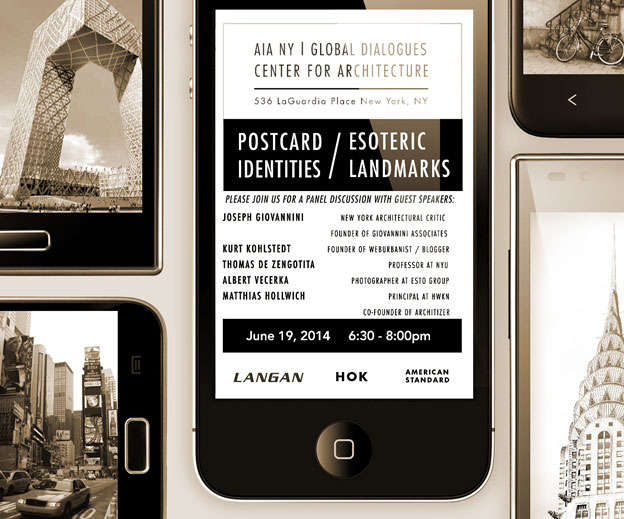by: chas
Social media is the root of much conversation, worry, speculation, and excitement across many fields and seems to pervade our everyday lives – so how is it affecting architecture, planning, and design? On 06.19.14, “Postcard Identities | Esoteric Landmarks” gathered speakers to discuss how these evolving technologies and methods of connecting people to one another – and to spaces – are changing how projects are conceived, and how people create and interact with iconic images and landmarks. If the proliferation of instantly shareable moments, photographs, and feedback is fundamentally changing how we, as users and creators, relate to space, what does this mean for the future of the profession?
Joseph Giovannini, architectural critic and founder of Giovannini Associates, opened the evening with a consideration of previous major milestones in the relationship between photography and architecture. Developments like commercially-produced photo albums and handheld cameras brought images of buildings to a larger audience, motivating architects to design for the page and conceive of buildings as objects to be admired. Giovannini posited that today’s use of social media to document everyday life as well as milestones has restored our spatial relationship to buildings – they often function as a backdrop to our own experiences that are then shared with others, potentially driving a growing movement to design for experience rather than solely for image.
Matthias Hollwich, co-founder of HWKN and Architizer, shared how several of the firm’s recent projects, particularly “Wendy” in the MoMA PS 1 courtyard and the Fire Island Pines Pavilion, were shaped largely by considering the public’s reaction and emotional connections to the finished products. He emphasized the power of personality to function as a “social glue,” drawing on interpersonal relationships to infuse the built environment with its own personality that would inspire connection and draw visitors. In both cases, the projects’ messy, active personalities were established during construction, when the transparency of instant sharing allowed communities to form enduring connections to the structures before they were even completed. Hollwich ended by urging architects to take advantage of transparency and ubiquitous sharing to push iconography further, creating emotional bonds with occupants and visitors.
Kurt Kohlstedt, founder and executive editor of WebUrbanist, presented several exciting examples of how social media is already transforming design, and what shareability means for how we experience space. Some standouts included public art and civic identity projects powered by social media, including: Favela Painting in Brazil or the Rainbow Steps in Turkey; digitally shared observations that effected real change in urban planning, like sneckdowns in Philadelphia; and mapping and visualization tools that help create a full image of a place, such as hyperlapses. Kohlstedt’s excitement over the proliferation of digital media in this field stems partly from the fact that it makes everyone a storyteller and enables us to bring spatial experiences to others who may never visit a particular place except through someone else’s lens.
Albert Vecerka, a photographer with Esto, drew on his background in both photography and architecture to demonstrate how the double curation in traditional architectural photography – first from the photographer and then from the editor – is being eroded by social media and image sharing. Although these images used to be carefully crafted before being shot and shared, meant to highlight multiple key features of a subject, today’s social photography is presenting buildings the way people really experience them, rather than in an artificial state of perfection.
Thomas de Zengotita, professor at the NYU Draper Graduate Program, focused largely on how living in a mediated world has shifted what we perceive to be iconic, particularly older signage in New York City – Kentile Floors, Pepsi, Domino Sugar – due to their real, gritty, messy aesthetic. The search for unmediated authenticity has spawned trends from the artisanal food movement to the surge in restored historic cities and downtowns, which he argues have all been designed in the same visual vein, signaling to us “historic” and “authentic.” These observations were interwoven with a fair amount of hand-wringing from de Zengotita about whether people, particularly younger generations growing up immersed in media, will become self-involved and desensitized to the outside world to a dangerous degree. Such concerns are nothing new. As de Zengotita himself admitted, they are, in a sense, reiterations of age-old complaints expressed by older generations about younger ones. But such concerns seem overshadowed by the excitement around harnessing the power of social media to truly design for end-user experiences.
One major question brought up by the presentations and panel discussion is that of control. What will come of the tension between the creator’s intention for a building or space and the meaning that is formed through the user experience, shared so easily through social media? The emotional, participatory, action-oriented nature of these experiences is so contrary to the long-held image of buildings and icons as established structures that it is easy to see the divisions between designers who are eager to empower users and those who want to hold on to their control and vision for their creations.
Editor’s Note: If you missed “Postcard Identity,” a recording of the program is available for viewing on the Center for Architecture’s Vimeo page, here.
Cassie Hackel is a social research specialist at Plastarc Design Metrics and holds a Bachelor of Arts in Urban Studies.
Event: Postcard Identity | Esoteric Landmarks
Location: Center for Architecture, 06.19.14
Speakers: Matthias Hollwich, SBA, Principal, HWKN, and Co-founder, Architizer; Kurt Kohlstedt, Founder, WebUrbanist; Thomas de Zengotita, Professor, Draper Graduate Program, NYU and the Dalton School; Albert Vecerka, Photographer, Esto; and Joseph Giovannini, Architectural Critic and Founder, Giovannini Associates (moderator)
Organizers: AIANY Global Dialogues Committee
Sponsors: HOK and American Standard









